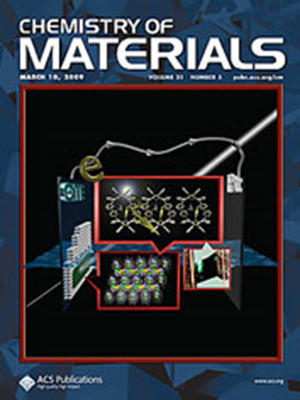基于粗粒度模型的甲基纤维素链设计对凝胶和纤维结构的影响
IF 7
2区 材料科学
Q2 CHEMISTRY, PHYSICAL
引用次数: 0
摘要
甲基纤维素(MC)的水溶液经过热可逆凝胶化,使其可用作具有所需流变性质的配方添加剂。这种凝胶化发生在高温下,同时形成由几个MC链组成的刚性、高长径比的原纤维。溶胶-凝胶转变温度和凝胶状态的纤维状结构可以通过MC链的分子量、MC浓度和MC链的设计来控制。一个这样的MC设计参数是取代度(DS),它在0(纤维素)到3.0(完全甲基化的纤维素链)之间变化。市售MC(例如,国际香精香料公司的Methocel A)的DS为1.8。沿MC主链的DS以及甲基化模式(即均相或异相取代)可以使用合成方案的变化来定制。为了阐明这些MC链设计参数对MC链溶胶-凝胶转变和纤维状结构的影响,我们进行了多尺度计算研究。首先,我们建立了MC的粗粒度(CG)模型,该模型的键合参数来自Boltzmann反演的原子模拟,非键合参数来自先前使用代理贝叶斯优化的水相MC溶胶-凝胶相行为的实验研究。利用该CG模型对MC水溶液进行了分子动力学模拟,表征了DS和甲基化模式对凝胶温度和MC链纤维结构的影响,特别是纤维直径和持续长度。我们模拟系统中的纤维直径和持续长度与之前的小角度散射分析和电子显微镜测量结果一致,为CG MD模拟结果提供了验证。使用这些CG MD模拟,我们跨越了一个大的MC设计参数空间,并确定了这些关键的设计规则:(i) MC链在沿链主链的DS具有较大的非均质性的水溶液将在较低的温度下凝胶化并组装成直径较小的原纤维。(ii)随着DS沿MC主链变得“堵塞”,在较低的温度下会发生凝胶化,纤维直径会减小。我们希望我们的模型开发和上述设计规则将有助于未来的工作,重点是合成和/或模拟具有定制凝胶特性的MC,以满足所需的应用。本文章由计算机程序翻译,如有差异,请以英文原文为准。

Effect of Methylcellulose Chain Design on Gelation and Fibril Structure Using Coarse-Grained Modeling
Aqueous solutions of methylcellulose (MC) undergo thermoreversible gelation making them useful as additives for formulations with desired rheological properties. This gelation occurs at elevated temperatures and concurrently with the formation of stiff, high aspect ratio fibrils composed of several MC chains. The sol–gel transition temperature as well as the fibrillar structure of the gel state can be controlled by the molecular weight of the MC chains, MC concentration, and the design of the MC chains. One such MC design parameter is the degree of substitution (DS) which varies between 0 (cellulose) to 3.0 (fully methylated cellulose chain). The DS of commercially available MC (e.g., International Flavors and Fragrances’ Methocel A) is ∼1.8. The DS as well as the pattern of methylation (i.e., homogeneous or heterogeneous substitution) along the MC backbone can be tailored using variations in the synthesis protocols. To elucidate the effect of these MC chain design parameters on the sol–gel transition and the fibrillar structure of the MC chains, we conducted a multiscale computational study. First, we developed a coarse-grained (CG) model for MC with the model’s bonded parameters informed from atomistic simulations using Boltzmann inversion and nonbonded parameters informed from previous experimental studies of aqueous MC sol–gel phase behavior using surrogate Bayesian optimization. We performed molecular dynamics (MD) simulations of aqueous MC solutions with this CG model and characterized the effect of DS and methylation pattern on the gelation temperature and the MC chains’ fibril structure, specifically fibril diameter and persistence length. Fibril diameters and persistence lengths in our simulated systems agree well with those found from previous small-angle scattering analysis and electron microscopy measurements, providing validation for the results from the CG MD simulations. Using these CG MD simulations, we span a large MC design parameter space and identify these key design rules: (i) Aqueous solutions with MC chains having larger heterogeneity in the DS along the chain backbone, will gel at lower temperatures and assemble into fibrils with a smaller diameter. (ii) As the DS becomes “blockier” along the MC backbone, gelation will occur at lower temperatures, and fibril diameters will decrease. We expect our model development and the above design rules will aid future work focused on synthesis and/or simulation of MC with tailored gel properties for desired applications.
求助全文
通过发布文献求助,成功后即可免费获取论文全文。
去求助
来源期刊

Chemistry of Materials
工程技术-材料科学:综合
CiteScore
14.10
自引率
5.80%
发文量
929
审稿时长
1.5 months
期刊介绍:
The journal Chemistry of Materials focuses on publishing original research at the intersection of materials science and chemistry. The studies published in the journal involve chemistry as a prominent component and explore topics such as the design, synthesis, characterization, processing, understanding, and application of functional or potentially functional materials. The journal covers various areas of interest, including inorganic and organic solid-state chemistry, nanomaterials, biomaterials, thin films and polymers, and composite/hybrid materials. The journal particularly seeks papers that highlight the creation or development of innovative materials with novel optical, electrical, magnetic, catalytic, or mechanical properties. It is essential that manuscripts on these topics have a primary focus on the chemistry of materials and represent a significant advancement compared to prior research. Before external reviews are sought, submitted manuscripts undergo a review process by a minimum of two editors to ensure their appropriateness for the journal and the presence of sufficient evidence of a significant advance that will be of broad interest to the materials chemistry community.
 求助内容:
求助内容: 应助结果提醒方式:
应助结果提醒方式:


